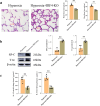IRF4-mediated Treg phenotype switching can aggravate hyperoxia-induced alveolar epithelial cell injury
- PMID: 38491484
- PMCID: PMC10941512
- DOI: 10.1186/s12890-024-02940-y
IRF4-mediated Treg phenotype switching can aggravate hyperoxia-induced alveolar epithelial cell injury
Abstract
Bronchopulmonary dysplasia (BPD) is characterized by alveolar dysplasia, and evidence indicates that interferon regulatory factor 4 (IRF4) is involved in the pathogenesis of various inflammatory lung diseases. Nonetheless, the significance and mechanism of IRF4 in BPD remain unelucidated. Consequently, we established a mouse model of BPD through hyperoxia exposure, and ELISA was employed to measure interleukin-17 A (IL-17 A) and interleukin-6 (IL-6) expression levels in lung tissues. Western blotting was adopted to determine the expression of IRF4, surfactant protein C (SP-C), and podoplanin (T1α) in lung tissues. Flow cytometry was utilized for analyzing the percentages of FOXP3+ regulatory T cells (Tregs) and FOXP3+RORγt+ Tregs in CD4+ T cells in lung tissues to clarify the underlying mechanism. Our findings revealed that BPD mice exhibited disordered lung tissue structure, elevated IRF4 expression, decreased SP-C and T1α expression, increased IL-17 A and IL-6 levels, reduced proportion of FOXP3+ Tregs, and increased proportion of FOXP3+RORγt+ Tregs. For the purpose of further elucidating the effect of IRF4 on Treg phenotype switching induced by hyperoxia in lung tissues, we exposed neonatal mice with IRF4 knockout to hyperoxia. These mice exhibited regular lung tissue structure, increased proportion of FOXP3+ Tregs, reduced proportion of FOXP3+RORγt+ Tregs, elevated SP-C and T1α expression, and decreased IL-17 A and IL-6 levels. In conclusion, our findings demonstrate that IRF4-mediated Treg phenotype switching in lung tissues exacerbates alveolar epithelial cell injury under hyperoxia exposure.
Keywords: Bronchopulmonary dysplasia; Forkhead transcription factor 3; Interferon regulatory factor 4; Regulatory T cells; Retinoic acid-related orphan nuclear receptor.
© 2024. The Author(s).
Conflict of interest statement
The authors declare no competing interests.
Figures






References
MeSH terms
Substances
Grants and funding
LinkOut - more resources
Full Text Sources
Research Materials

